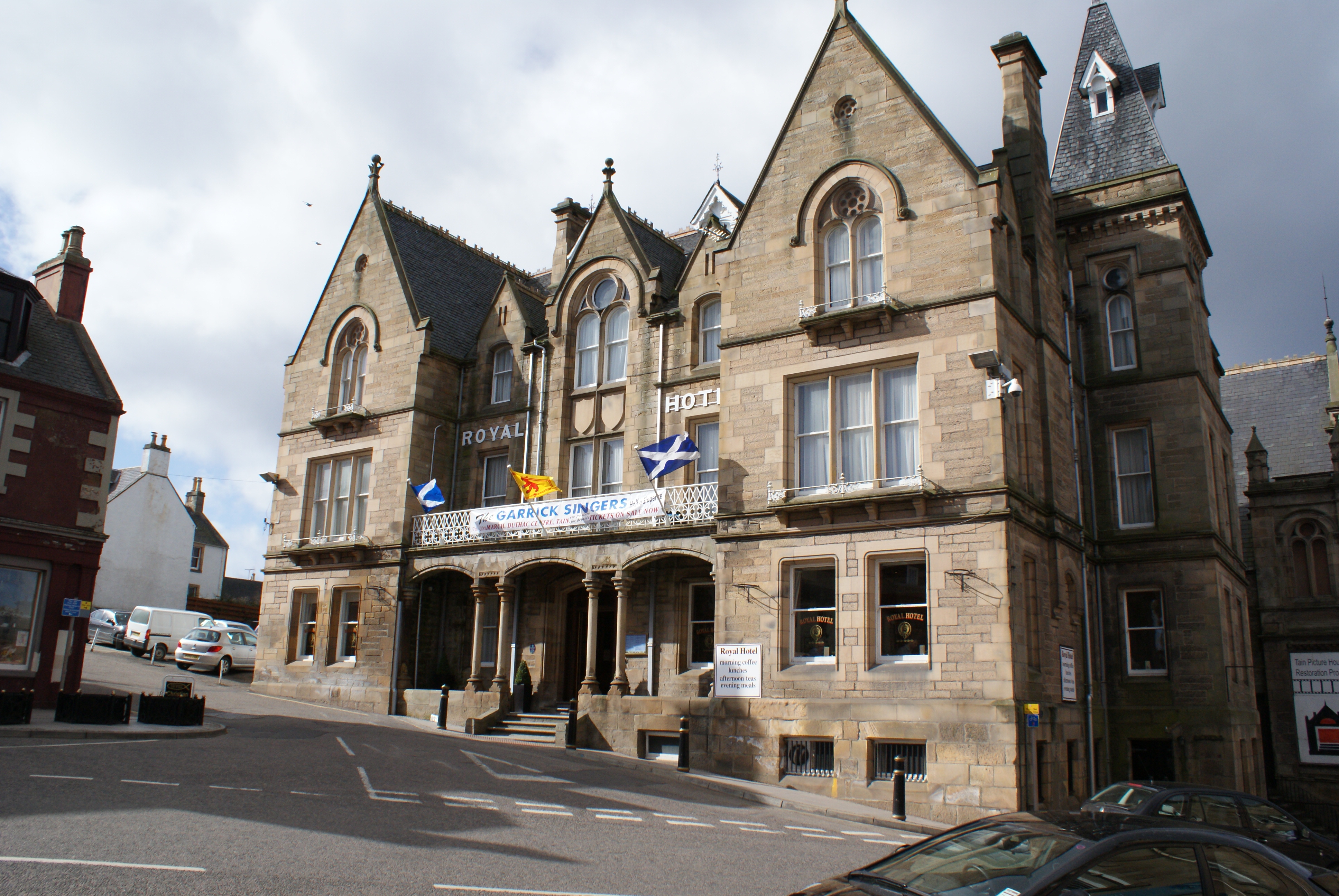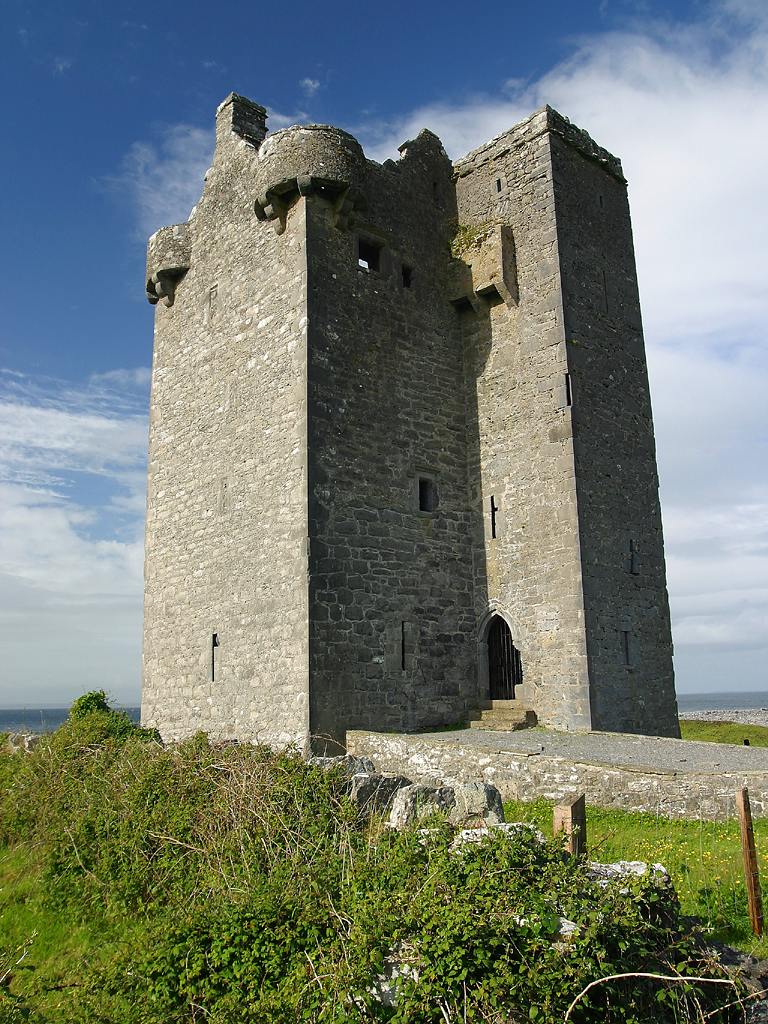|
Loch Slin Castle
Loch Slin Castle (sometimes spelt Lochslin) is a ruined castle near Fearn, Highland, Scotland. From the 15th to 17th centuries it was the seat of the Vass (sept), Vass family. The castle stood close to Loch Eye on the boundary of the parishes of Tain and Tarbat, but takes its name from an earlier name of the nearby loch. Architecture The last upstanding part of the castle collapsed on 31 January/1 February 1953. However, old photographs clearly show that it had a high-level corbelled angle turret. It also had cable-moulded decoration comparable to that at Castlecraig. The building was an L-plan castle with the kitchen on the first floor, and seems to have been similar in layout to Castle Leod and other Mackenzie residences. Although according to Geoffrey Stell it is very doubtful that the castle was actually built by the Mackenzies who did not come into possession of it until 1624. The castle consisted of two nearly square keeps with staircases in the corners. According to the '' ... [...More Info...] [...Related Items...] OR: [Wikipedia] [Google] [Baidu] |
Loch Slin Castle
Loch Slin Castle (sometimes spelt Lochslin) is a ruined castle near Fearn, Highland, Scotland. From the 15th to 17th centuries it was the seat of the Vass (sept), Vass family. The castle stood close to Loch Eye on the boundary of the parishes of Tain and Tarbat, but takes its name from an earlier name of the nearby loch. Architecture The last upstanding part of the castle collapsed on 31 January/1 February 1953. However, old photographs clearly show that it had a high-level corbelled angle turret. It also had cable-moulded decoration comparable to that at Castlecraig. The building was an L-plan castle with the kitchen on the first floor, and seems to have been similar in layout to Castle Leod and other Mackenzie residences. Although according to Geoffrey Stell it is very doubtful that the castle was actually built by the Mackenzies who did not come into possession of it until 1624. The castle consisted of two nearly square keeps with staircases in the corners. According to the '' ... [...More Info...] [...Related Items...] OR: [Wikipedia] [Google] [Baidu] |
Fearn, Highland
Fearn ( gd, Manachainn Rois) is a hamlet, situated south of Loch Eye and northwest of Balintore, in eastern Ross-shire, Scottish Highlands and is in the Scottish council area of Highland. The buildings in the hamlet are mostly cottages with walls constructed of boulders and clay. Fearn Abbey was erected in the hamlet in 1238 by Farquhar, first Earl of Ross, and rebuilt in 1771 after its roof collapsed in 1742. The larger village of Hill of Fearn Hill of Fearn ( gd, Baile an Droma) is a small village near Tain in Easter Ross, in the Scottish council area of Highland. Geography The village is on the B9165 road, between the A9 trunk road and the smaller hamlet of Fearn to the southeast ... lies directly northeast of the hamlet. The former RNAS Fearn (HMS Owl) is to the south of the hamlet. References Populated places in Ross and Cromarty Parishes in Ross and Cromarty {{Highland-geo-stub ... [...More Info...] [...Related Items...] OR: [Wikipedia] [Google] [Baidu] |
Scotland
Scotland (, ) is a country that is part of the United Kingdom. Covering the northern third of the island of Great Britain, mainland Scotland has a border with England to the southeast and is otherwise surrounded by the Atlantic Ocean to the north and west, the North Sea to the northeast and east, and the Irish Sea to the south. It also contains more than 790 islands, principally in the archipelagos of the Hebrides and the Northern Isles. Most of the population, including the capital Edinburgh, is concentrated in the Central Belt—the plain between the Scottish Highlands and the Southern Uplands—in the Scottish Lowlands. Scotland is divided into 32 administrative subdivisions or local authorities, known as council areas. Glasgow City is the largest council area in terms of population, with Highland being the largest in terms of area. Limited self-governing power, covering matters such as education, social services and roads and transportation, is devolved from the Scott ... [...More Info...] [...Related Items...] OR: [Wikipedia] [Google] [Baidu] |
Vass (sept)
The Vass family (sometimes spelt Vaus, Wass or Waus) were a minor noble Scottish family, but also recognised septs of the Clan Ross and Clan Munro, both Scottish clans of Ross-shire in the Scottish Highlands. History Origins in Scotland The names Vass and Wass were originally de Vallibus or Vaux and were derived from John Vaux or de Vallibus who was a Norman settler and who witnessed a charter in Kincardine, Sutherland by Alexander III of Scotland in 1252.Vass, History Of cadzow.com.au. Quoting: ''The Septs of the Highland Clans''. Retrieved 16 August 2016. Scottish clan affiliations As the and |
Tain
Tain ( Gaelic: ''Baile Dhubhthaich'') is a royal burgh and parish in the County of Ross, in the Highlands of Scotland. Etymology The name derives from the nearby River Tain, the name of which comes from an Indo-European root meaning 'flow'. The Gaelic name, ''Baile Dubhthaich'', means 'Duthac's town', after a local saint also known as Duthus. History Tain was granted its first royal charter in 1066, making it Scotland's oldest royal burgh, commemorated in 1966 with the opening of the Rose Garden by Queen Elizabeth, the Queen Mother. The 1066 charter, granted by King Malcolm III, confirmed Tain as a sanctuary, where people could claim the protection of the church, and an immunity, in which resident merchants and traders were exempt from certain taxes. Little is known of earlier history although the town owed much of its importance to Duthac. He was an early Christian figure, perhaps 8th or 9th century, whose shrine had become so important by 1066 that it resulted in the royal ch ... [...More Info...] [...Related Items...] OR: [Wikipedia] [Google] [Baidu] |
Tarbat
Tarbat (Gaelic , meaning 'a crossing or isthmus'Place-names of Ross and Cromarty, by W J Watson, publ. The Northern Counties Printing and Publishing Co. Ltd., Inverness 1904; p.45) is a civil parish in Highland, Scotland, in the north-east corner of Ross and Cromarty. The parish is a promontory between Dornoch Firth to the north-west and Moray Firth to the east, while to the south it borders the parish of Fearn.Ordnance Gazetteer of Scotland: A survey of Scottish Topography statistical biographical and historical, by Francis H. Groome; publ. Thomas C. Jack, Edinburgh, 1882 - 1885. (Article on Tarbat) The peninsula is relatively flat, the highest point being the hill adjacent to Geanies House which reaches , on the southern border of the parish.Historic Environment Scotland Portal website (Article on Geanies House) portal.historicenvironment.scot/designation/GDL00217 Retrieved April 2021Ordnance Survey series 1 in. to 1 mile Sheet 22 - Dornoch, Publ. 1965 The coast along the D ... [...More Info...] [...Related Items...] OR: [Wikipedia] [Google] [Baidu] |
L-plan Castle
An L-plan castle is a castle or tower house in the shape of an L, typically built from the 13th to the 17th century. This design is found quite frequently in Scotland, but is also seen in England, Ireland, Romania, Sardinia, and other locations. The evolution of its design was an expansion of the blockhouse or simple square tower from the Early Middle Ages. As building techniques improved, it became possible to construct a larger building footprint and a more complex shape than the simple blockhouse tower. A more compelling motivation for the L plan was the ability to defend the entrance door by providing covering fire from the adjacent walls. This stratagem was particularly driven by the advent of cannon used by attackers. It was common for the union of the two wings to have very thick wall construction to support a major defensive tower in the union area. For example, the stone walls of Muchalls Castle in Scotland are over 14 feet thick at the ground level. Built in the 13t ... [...More Info...] [...Related Items...] OR: [Wikipedia] [Google] [Baidu] |
Castle Leod
Castle Leod is the seat of the Clan Mackenzie. It is a category A listed building, and the grounds are listed in the ''Inventory of Gardens and Designed Landscapes of Scotland'', the national listing of significant gardens. It is located near Strathpeffer in the east of Ross-shire in the Scottish Highlands. History Background The castle was granted to John of Killin, 10th Chief of Clan MacKenzie (1485–1561) after he fought at the Battle of Flodden. The castle was passed to his great-grandson Kenneth Mackenzie, 1st Lord Mackenzie of Kintail, who granted it in 1608 to his brother Sir Roderick "Rorie" Mackenzie. In 1605 Sir Roderick married Margaret MacLeod, heiress of Torquil MacLeod of Lewis, bringing her immense wealth into the family and also settling the feud between the MacLeods and the Mackenzies over the Barony of Coigach, which thus passed into the Mackenzie family. Castle history The castle is believed to have been built on the site of a very ancient Pictish fort ... [...More Info...] [...Related Items...] OR: [Wikipedia] [Google] [Baidu] |
Castles In Scotland
Scottish castles are buildings that combine fortifications and residence, built within the borders of modern Scotland. Castles arrived in Scotland with the introduction of feudalism in the twelfth century. Initially these were wooden motte-and-bailey constructions, but many were replaced by stone castles with a high curtain wall. During the Wars of Independence, Robert the Bruce pursued a policy of castle slighting. In the Late Middle Ages, new castles were built, some on a grander scale as "livery and maintenance" castles that could support a large garrison. Gunpowder weaponry led to the use of gun ports, platforms to mount guns and walls adapted to resist bombardment. Many of the late Medieval castles built in the borders were in the form of tower houses, smaller pele towers or simpler bastle houses. From the fifteenth century there was a phase of Renaissance palace building, which restructured them as castle-type palaces, beginning at Linlithgow. Elements of Medieval castles, ... [...More Info...] [...Related Items...] OR: [Wikipedia] [Google] [Baidu] |
Ruined Castles In Highland (council Area)
Ruins () are the remains of a civilization's architecture. The term refers to formerly intact structures that have fallen into a state of partial or total disrepair over time due to a variety of factors, such as lack of maintenance, deliberate destruction by humans, or uncontrollable destruction by natural phenomena. The most common root causes that yield ruins in their wake are natural disasters, armed conflict, and population decline, with many structures becoming progressively derelict over time due to long-term weathering and scavenging. There are famous ruins all over the world, with notable sites originating from ancient China, the Indus Valley and other regions of ancient India, ancient Iran, ancient Israel and Judea, ancient Iraq, ancient Greece, ancient Egypt, Roman sites throughout the Mediterranean Basin, and Incan and Mayan sites in the Americas. Ruins are of great importance to historians, archaeologists and anthropologists, whether they were once individual fort ... [...More Info...] [...Related Items...] OR: [Wikipedia] [Google] [Baidu] |
.png)





.jpg)

